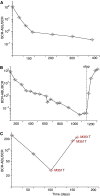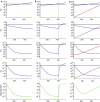Mathematical models of targeted cancer therapy
- PMID: 17031409
- PMCID: PMC2360553
- DOI: 10.1038/sj.bjc.6603310
Mathematical models of targeted cancer therapy
Abstract
Improved understanding of the molecular underpinnings of cancer initiation and progression has led to the development of targeted cancer therapies. The importance of these new methods of cancer treatment necessitates further research into the dynamic interactions between cancer cells and therapeutic agents, as well as a means of analysing their relationship quantitatively. The present review outlines the application of mathematical modelling to the dynamics of targeted cancer therapy, focusing particular attention on chronic myeloid leukaemia and its treatment with imatinib (Glivec).
Figures


References
-
- Araujo RP, Petricoin EF, Liotta LA (2005) A mathematical model of combination therapy using the EGFR signaling network. Biosystems 80: 57–69 - PubMed
-
- Beutler E, Lichtman MA, Coller BS, Kipps TJ, Seligsohn U (2000) Williams Hematology. New York, USA: McGraw-Hill
-
- Bhatia R, Holtz M, Niu N, Gray R, Snyder DS, Sawyers CL, Arber DA, Slovak ML, Forman SJ (2003) Persistence of malignant hematopoietic progenitors in chronic myelogenous leukemia patients in complete cytogenetic remission following imatinib mesylate treatment. Blood 101: 4701–4707 - PubMed
-
- Branford S, Rudzki Z, Walsh S, Parkinson I, Grigg A, Szer J, Taylor K, Herrmann R, Seymour JF, Arthur C, Joske D, Lynch K, Hughes T (2003a) Detection of BCR-ABL mutations in patients with CML treated with imatinib is virtually always accompanied by clinical resistance, and mutations in the ATP phosphate-binding loop (P-loop) are associated with a poor prognosis. Blood 102: 276–283 - PubMed
-
- Branford S, Rudzki Z, Grigg A, Seymour JF, Taylor K et al (2003b) The incidence of BCR-ABL kinase mutations in chronic myeloid leukemia patients is as high in the second year of imatinib therapy as the first but survival after mutation detection is significantly longer for patients with mutations detected in the second year of therapy. Blood 102: 414
Publication types
MeSH terms
Substances
LinkOut - more resources
Full Text Sources

